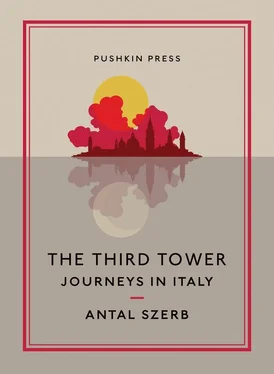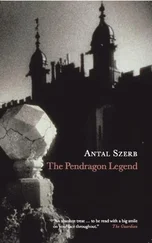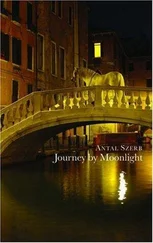AFTER DINNER I sit on the terrace of a coffee house. The square is no larger than a middle-class dining room, and yet five busy streets pour into it. It is pure theatre, Italy as represented in the opera. And the population comes and goes, rushing about in a vast crowd. It is hard to believe that there could be so many Italians — especially towards evening. All coming and going. But where to? And always along the same streets, until they are two-thirds empty.
On the coffee-house radio the Italian commentator Pluhar is reporting on some Olympic contest. His delivery is calm and expressionless; it carries no trace of his usual infectious excitement. You would have thought that the Italians…
The streets are filled with large numbers of elderly men in sailor’s tops and trousers; they are indeed sailors. Among the general throng one sees the occasional figure clad in white drill and pith helmet. These are police. They stroll about in their white uniforms like Englishmen among the natives.
AND SO MANY WOMEN! Venetian women go about bareheaded, and they are all decidedly plain. Compared to them the women of Paris are genuinely beautiful. There are plenty of blondes to be seen: partly because the Venetian type, as we know from our Burckhardt, tended to blondeness even in the Renaissance, and partly because they follow the currently fashionable Anglo-Saxon ideal of beauty and bleach their hair. The paradox of their faces lies in the fair Teutonic hair and the fine-chiselled Latin features. The two somehow do not sit well together. The faces of the men have their own paradox: along with their prominent Romano-Jewish noses and beautiful Southern eyes they have ears that stick out, like the Germans. You do see younger men who are exceedingly handsome, but the women are not in the least attractive. But no doubt very respectable. In Venice I saw only one street girl, and even she was walking arm in arm with her mother. Yet I was solicited by another, who cannot have been twelve.
There is no shortage of them. But in Italy even I am respectable. In Paris and London my amorous fantasies burned with a persistent and restless flame. I imagined that within the unfamiliar houses (and the unfamiliar women, of a different racial type) lurked a whole new world of feelings and pleasures. In Italy I don’t feel even the usual low level of sexual restlessness that inevitably characterizes my bachelor existence. Women simply don’t interest me. In Venice I have no need of them. The reason: Venice is herself a woman, mysterious and alluring, in her brick-pink serenity.
THERE IS AN EXHIBITION on at the Palazzo Rezzonico: Memoirs of Eighteenth-Century Venice. I went because I was curious to see what one of these Canal Grande mansions would be like from inside, and because I am deeply drawn to the Venice of this period, Casanova’s Venice. The ceiling of the main room is adorned with frescos by Tiepolo — Rococo Learning with the angel’s firebrand in his fist driving out Ignorantia. Happy Eighteenth Century! Wherever did Ignorantia, thus driven out, dwell, and in what remarkable sanatorium, that she now returns in such rude health, with such renewed vigour?
So many paintings! It is interesting — and I don’t fully understand why this is — that in the eighteenth century the faces that gaze out at us from portraits are generally thoughtful and fine-featured, while in the tableaux and genre paintings of the same period they are as expressionless as dolls. How different are these studies of the Rezzonico family! Centre stage is the portly, sagacious, rather cold-looking Clement XIII, Casanova’s Pope, “Papa Rezzonico” (he only ever refers to him as such, and does so frequently and with affection: he was immensely proud of him, as a Venetian). Around His Holiness stand other members of the family: a cardinal, a state councillor and the little nipoti , his “cousins” presumably: I’ve no idea what this word signifies, whether rank or function.
The pictures are dominated by masks — the masks about which I have read so much in Casanova’s writings. But only now do I know how they were painted. A huge black cape, a black three-pointed hat and the white face mask attached, with a terrifying beaklike nose, the whole producing an effect of powerful mystery and menace. They could be in a detective film, were they not somehow spiritual and altogether of a higher order. The gentlemen of the city wore such masks during the Carnival so that they could mingle freely with the populace without dishonouring their rank, and, since the Carnival could last for months, that is how long they would wear them. In Casanova’s day the mask was Venice. The hideous, beaklike visor held some essence, something demonic, some ancient principle of evil, that was so old and so refined that even today it stirs us no less powerfully than goodness and great acts of love.
THIS QUIET COUNTRY TOWN is famous for Palladio, the last great architect of the Renaissance, who lived and worked here. He achieved especial renown when his art was discovered by Goethe, for it was here that Goethe first encountered the characteristic harmony of his lines, the purity of his Classicism. The Northern psyche is essentially inward-looking: at Versailles the Germans exclaimed aloud at the imperial magnificence of the place, but here in Vicenza they found what most sublimely expressed their soul.
Not the least aspect of the grandeur of Italy is that so many of the events that shaped that Northern psyche took place in this part of the world. The greatest of the Northern peoples — the legendary heroes of the Völkerwanderung (the “Age of Migrations”) and the visionary emperors of the Middle Ages — lived and died here. They all shared a deep love of Italy. Later, in gentler and more harmonious times, the warriors were succeeded by poets, and, in more literary centuries, by a holy trinity of English lyricists. Here the great Lord Byron, that marvellous barnstormer, lived and loved; here John Keats, the passionate celebrant of the Grecian urn, came to exhale his dying breath; and here the corpse of the angel-faced Shelley was burnt on the pyre. As we travel further south we meet their footsteps everywhere, until we find ourselves at last in Rome, standing, profoundly moved, beside the graves of two of the trio, in the little cemetery beside the tomb of Cestius that Shelley described as accurately as if he had seen it himself. Perhaps Italy would not be Italy if the dreams of these men from the North did not still hover over its landscapes, and if it were not, at least in the minds of the poets, at once the most vividly real and the most fantastical of all countries. What would I have ever known about Italy had those intellectual giants of earlier times not come here, three of them English, and three German: Goethe, seeking the line of antique purity, Jean Paul, the paradisal wanderer, and Eichendorff, for whom the summer nights of Italy held a mystical significance?

So here came Goethe, in his great cloak and enormous hat, to gaze at Palladio’s noble buildings, to take an interest in the way ordinary people dressed and in what they ate, to attend a meeting of the Academy of Olympus, and to regret that the poets of his own country could not similarly present themselves in the marketplace to display their national art ( persönlich belustigen ). And even as he stood there contemplating these thoughts, the Iphigenia was taking shape inside him. Palladio’s harmony had quelled the Furies in his soul, had cleansed and purified it, much as Iphigenia had done for Orestes. The serenity of Italy, that ultimate vision of the calm perfection of the soul, flooded into him. That is what his name stands for in the memory of mankind.
Читать дальше













